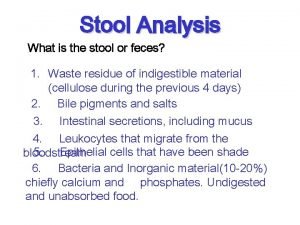General Stool Examination Medical Analysis Dep Third stage

















- Slides: 17

General Stool Examination Medical Analysis Dep. Third stage Scatology (Caprology) by: Dr. Hemdad H. Mawlood





Macroscopic Finding 1. PH 2. Color 3. Odor 4. Consistency 5. Part of parasite or and adult parasite

COLOR of Stool 1. Normal color stool color is brown. This is due to the presence of bile in the stool. Normal stool color can range from light yellow to brown. If stool is Red, Maroon, Black, clay- colored, Pale yellow, or Green this may signify a problem.

2. Black Stools (Not Sticky, No Odor) Causes of black stool include iron pills or bismuth-containing medications (such as, bismuth subsalicylate (Anti-acid)or Pepto-Bismol). If the stool color is dark because of any of these medications, it is typically not sticky in texture and is not foul-smelling.

3. Black Tarry, Sticky Stools Bleeding in the stomach (from gastritis or an ulcer) or the intestines can change the color of stool. If bleeding occurs in the stomach or the upper part of the small intestine, the stool may turn black and sticky, and be described medically as black, tarry stool (Melena). Generally, black, tarry stool also is foul-smelling. This change in color and consistency occurs because of chemical reactions to blood within the intestine that are caused by digestive enzymes within the intestines.

4. Maroon or Red Stools If the bleeding originates from lower parts of the intestines or in the colon, large amounts of blood within the intestines speed up transit of stool because of short distance so that there is less time for the changes to take place. The stool in this type of bleeding may be dark red or maroon in color. Beets, other red vegetables, cranberries, and red food dyes also can turn the stool color red or maroon.


5. Gray or Clay-Colored Stool can be Gray or Clay-colored if it contains little or no bile. The pale color may signify a condition (biliary obstruction) where the flow of bile to the intestine is obstructed, such as obstruction of the bile duct from a tumor or gallstone in the duct or nearby pancreas. The change of stool color to gray or clay typically occurs gradually as these medical conditions progress relatively slowly and stool becomes pale over time.

6. Yellow Stool that is yellow may suggest presence of undigested fat in the stool. This can occur as a result of diseases of the pancreas that reduce delivery of digestive enzymes to the intestines (pancreatic insufficiency), such as: A. Chronic pancreatitis (long standing inflammation and destruction of the pancreas usually due to alcohol abuse B. Obstruction of the pancreatic duct that carries the enzymes to the intestines (most commonly due to pancreatic cancer). C. Celiac disease: Another condition that possibly may cause yellow and greasy stool is celiac disease (a malabsorption syndrome). D. whight loss

Celiac disease is a digestive disorder that occurs in reaction to gluten, a protein found in rye, barley, wheat, and hundreds of foods made with these grains. The body's immune system reacts to the gluten and causes damage to the intestine. Celiac disease, also known as celiac sprue or gluten-sensitive enteropathy, is fairly common. One in 133 Americans has the disorder and needs to follow a gluten-free diet.


Weight loss medications such as orlistat (Xenical, alli) work by limiting the amount of fatabsorbed by the intestines. This can lead to bulky, yellow, and greasy stools.

7. Green Stool When stool passes through the intestines rapidly (diarrhea), there may be little time for bilirubin to undergo its usual chemical changes, and stool can appear green in appearance due to rapid transit. Eating excessive amounts of green foods, and vegetables also can cause stool color to turn more green than normal.































